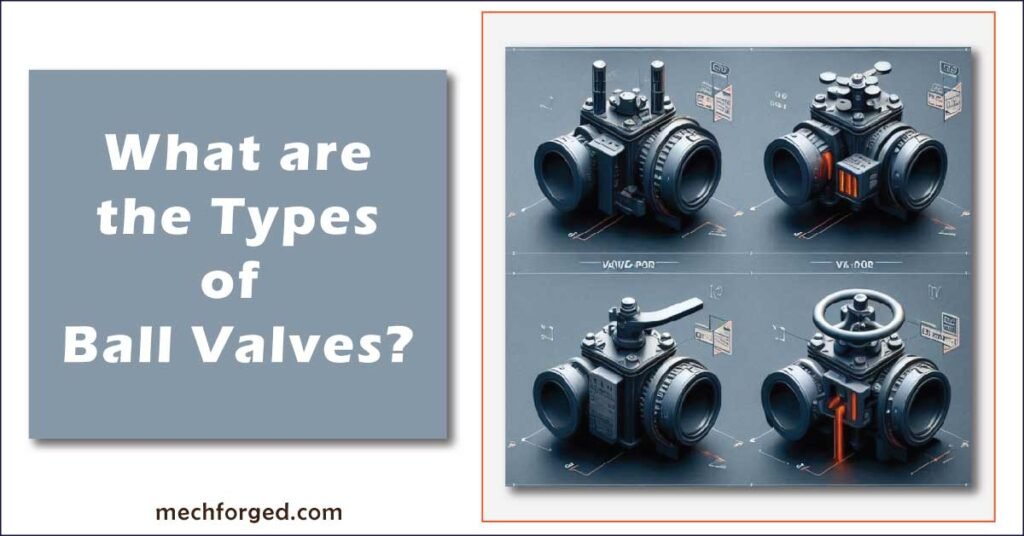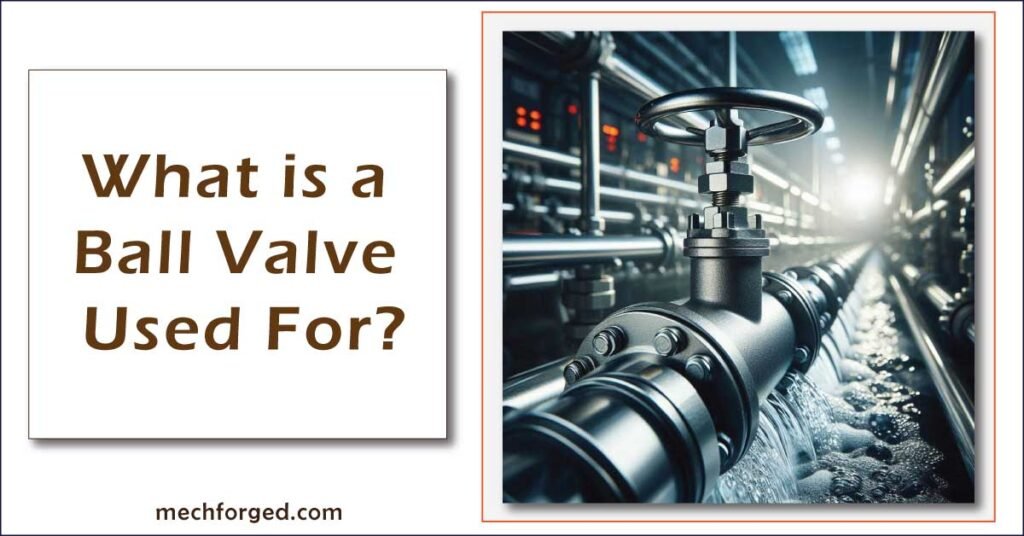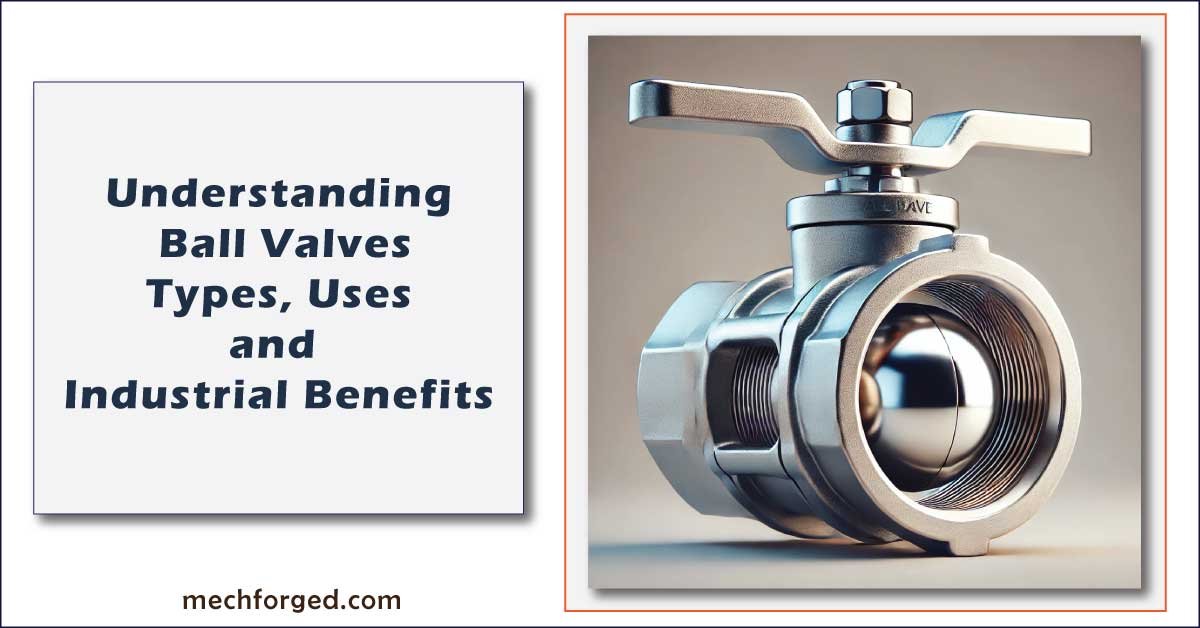Ball valves are highly important parts of a number of systems used in industrial, commercial and residential settings. Because of their structure, durability and capacity to adjust their functions to control processes involving liquids and gases, flow control valves are preferred. That is why in this article we will explain what the ball valve is, the existing types of this equipment, and the various fields in which it is practically mandatory.
What is a Ball Valve?
A ball valve is basic commodity which is essential for regulating the linear flow of fluids and commodities through industrial systems. This design is straightforward, although effective, and that’s why it is used in diverse scales from simple residential systems to industrial systems. Ball valve consists of a spherical disc, the ball that has bored hole in the middle of it. In the flow of the fluid through the valve body, this ball oscillates and in the direction of the hole either allows or blocks the fluid.
Materials used in construction of the valve may include: stainless steel, brass, bronze or a thermoplastic material such as PVC depending on type of application and the type of fluid to be controlled. The choice of materials allows the valve to be strong enough, and at the same time the valve is protected against corrosion, excessive pressure and high temperatures.
Working Principle and Key Components
It is quite difficult to give a working principle of a ball valve; it simply functions by having a round-shaped disc or a ball which can be rotated in order to open or to close the valve. The ball inside the valve is coupled with a stem which in turn is coupled with a knob or any other actuating mechanism on the outer surface of the valve. When the handle is turned, the ball rotates 90 degrees. If the hole in the ball aligns with the pipeline, fluid flows freely. If the ball is turned so that the hole is perpendicular to the pipeline, the flow is blocked. This quarter-turn operation is one of the reasons why ball valves are so popular—they are quick and easy to operate.
Key components of a ball valve include:
Body:
The body of a ball valve is the main structure that encloses and supports all internal components. Made from materials like stainless steel, brass, or PVC, it connects to the pipeline and withstands high pressures and harsh environments.
Ball:
The ball is the spherical element inside the valve that controls fluid flow. Typically made of metal or thermoplastic, it has a central hole that aligns with the pipeline to allow or block fluid flow, depending on its position.
Seats:
Seats are rings that form a seal between the ball and valve body, preventing leakage. They are made from soft or hard materials like rubber or PTFE, ensuring a tight seal when the valve is closed.
Stem:
The stem is the shaft that connects the ball to the handle or actuator. It transmits the rotational movement from the handle to the ball, enabling the control of fluid flow through the valve.
Handle or Actuator:
The handle or actuator is the external component used to turn the stem and ball. It allows manual or automated control of the valve’s position, enabling precise regulation of fluid flow through the valve.
The simple design of ball valves contributes to their reliability and longevity. They have fewer moving parts compared to other types of valves, which minimizes the risk of failure and reduces maintenance requirements.
Applications and Advantages Of Ball Valves
Ball valves are used in all mature of industries since they are quite versatile, strong and easy to manipulate. Some common applications include:
In conclusion, a ball valve is a highly effective and reliable component used to control fluid flow in various applications. Its simple design, combined with robust materials, ensures durability and versatility, making it a critical element in both industrial and residential systems.

What are the Types of Ball Valves?
1- Floating Ball Valves
Floating ball valves are one of the most common types of ball valves applied into industrial applications. This design is not having a ball as a fixed part but there is a location of the ball with the help of valve seats only. This makes the ball to be able to ‘float’ a little within the valve body. In the closed position and when pressure is applied the fluid acts on the ball and forces it to compress against the downstream seat thus sealing the valve. This design is suitable for use where there is need to exert high pressure of the sealing aspect but the pressure is not very high.
Floating ball valves are normally employed in the systems where moderate pressure ranges dominate. These are commonly used across sectors including oil and gas, water treatment and chemical processing industries. While selecting the type of float ball valve to offer, the material of construction of the valve body and trim can be selected depending on the type of fluid, and contains stainless steel, brass or plastic.
2- Trunnion Ball Valves
Trunnion ball valves are also approved to work at higher pressures and to losely used for the large sizes of pipes than the floating ball valves. In a trunnion ball valve there are two support or bearings or trunnions on the top and another on the bottom of the ball. This design is reduces the amount of force needed to operate the valve, making it easier to open and close even under high-pressure conditions. The trunnion design also reduces the wear and tear on the valve seats, extending the valve’s lifespan. Trunnion ball valves are the commonly used in industries where large-diameter pipelines are prevalent, such as in the oil and gas industry. Their ability to handle high pressures and large volumes of fluid makes them ideal for the critical applications where reliability is paramount. Additionally, trunnion ball valves are often to equipped with multiple seals and emergency sealant injection systems, further enhancing their safety and durability.
3- Multi-Port Ball Valves
Multi-port ball valves are further functional than other types of valves since it is capable of controlling the flow of fluids in different ports from the same valve. These types of valves are normally referred to as multiported valves since they have at least three ports and sometimes more; the ball se Hoodged within the valve is intended to control the flow of the fluid through various pathways. Multi-port ball valves are useful in cases, where the fluid has to be divided to several outputs, or where the mixing of the fluids occurs.
There are several configurations of multi-port ball valves, including:
T-Port: Allows for flow between three ports, often used to mix or divert flow.
L-Port: Directs flow between two out of three ports, typically used for diverting flow between two different pipelines.
These valves are applied especially in food and drinks processing companies, the manufacturing of medicine and chemicals, and processing of various chemicals where flow direction and feed rate of the fluid are critical. Since it is possible to integrate more than one function in a single valve, it eliminates the need for additional pipes and other requirements hence minimizing the construction budget.
4- Specialty Ball Valves
Beyond the standard types, there are specialty ball valves designed for specific applications:
V-Port Ball Valves: Feature a V-shaped notch in the ball, allowing for more precise control over flow rates. These valves are used in applications requiring accurate throttling, such as in chemical dosing or flow control systems.
Cavity-Filled Ball Valves: Designed to eliminate cavities within the valve body where fluids can become trapped. These are ideal for hygienic applications in the food and pharmaceutical industries.
Top Entry Ball Valves: Allow for easy maintenance and repair without removing the valve from the pipeline. They are often used in applications where downtime needs to be minimized.
In summary, the different types of ball valves offer solutions for a wide range of applications, from low-pressure residential systems to high-pressure industrial pipelines. Understanding the specific requirements of your application is key to selecting the right type of ball valve, ensuring optimal performance and longevity.

What is a Ball Valve Used For?
1. Oil and Gas Pipelines
Ball valves are widely applied for the regulation of the oil and gas transport pipelines for the transport of crude oil, natural gas and other similar products. Due to their high pressure performance and good sealing characteristics, they are used for separating areas of pipeline maintenance or accidents.
2. Chemical Processing
In chemical plants, ball valves are used to manage the flow of corrosive and hazardous chemicals. Their resistance to aggressive substances and ability to prevent leakage ensure safety and efficiency in processes involving acids, solvents, and other reactive materials.
3. Water Treatment Plants
Every industry that deals with water treatment has to use ball valves to regulate the flow of water from one stage of processing to the other, or from an inflowing source directly to the point of use. Some of them assist in preventing the variation in flow rates, and guarantee the delivery of treated water without being contaminated.
4. Fire Protection Systems
Ball valves are critical components in fire protection systems, such as sprinklers and hydrants. They allow for the quick and reliable shut-off of water supply, helping to control fires and prevent water damage after the fire is extinguished.
5. Residential Plumbing
In residential plumbing, ball valves are used in regulating the flow of water to fixtures in the building like; sinks, toilets, washing machines among others. Some are favoured for their efficiency and convenience; they afford the occupants a hassle free method of turning off the water supply when required.
6. HVAC Systems
Heating, ventilation, and air conditioning (HVAC) systems are also employ ball valves for control the flow of fluids which include water; air and refrigerants. This assists in sustaining the right management and productivity of the system, and hence the preservation of climate in the structures.
7. Automotive Fuel Systems
Ball valves are utilized in automotive fuel systems to be able to control the flow of fresh gasoline or diesel. Due to their strong construction and relatively high pressure capabilities they are suitable for the purpose of delivering fuel to the engine without delays and in a safe manner.
8. Pharmaceutical Manufacturing
They are employed in the pharmaceutical production activities since the execution of the processes involves very high stringency and accuracy as well as require very high degree of cleanliness. They assist in regulating fluids and gases particularly in aseptic processes so that they manufacture products without introducing any contaminants into the process.
9. Food and Beverage Processing
Ball valves are prevalent widely in the food and beverage industry to allow the regulation of the ingredients, water and cleaning agents. This is done in a sanitary manner hence reducing the chances of bacteria build up and products that are processed are often free from bacteria.
10. Marine Applications
The parts and components manufactured from ECTFE or ETFE materials are resistant to corrosion, and therefore well suited to use in marine applications where they are used for ballast and cooling system.
These applications highlight the effectiveness and durability of the Ball valves for controlling flow of distinct types of fluids in different industries.
11. Cryogenic Applications
Ball valves are particularly useful where very low temperature is expected like in the use of LNG (liquefied natural gas) as well as liquid nitrogen. These valves are intended to be used in cryogenic applications which means they do not freeze and are also capable to seal the cryogenic fluids without losing functionality.
12. Irrigation Systems
In agricultural irrigation systems, ball valves are used to control the flow of water to different sections of fields or gardens. Their ability to provide a quick and reliable shut-off makes them ideal for managing water distribution efficiently, helping farmers optimize water usage and improve crop yield.
13. Mining Operations
Ball valves play a crucial role in mining operations, where they are used to control the flow of slurry, chemicals, and water in various processes such as ore extraction, washing, and transport. The valves’ durability and resistance to abrasion and corrosion are vital for handling the harsh conditions found in mining environments.
14. Power Generation
In power station, ball valves is to control the steady stream or fluid such as steam and water and other fluids used in production of electricity. They are of great significance especially in the regulation of steam in turbines and the boilers used in producing power and heat respectively.
15. Pneumatic Systems
Ball valves are fixed in Pneumatic systems to help regulate the compressed air or any kind of gases used in the system. These systems are commonly found in manufacturing, automation, and robotics, where the valves help regulate air pressure and flow, ensuring the proper operation of pneumatic tools, cylinders, and other equipment.
Conclusion
Ball valves are versatile and robust components critical to many industries, from oil and gas to residential plumbing. Understanding their types and applications helps in selecting the right valve for specific needs, ensuring efficiency, safety, and longevity. Whether for industrial process control or everyday household use, ball valves remain a reliable and efficient solution for fluid management.
Mechanical Tools and Their Uses: Mechanical tools are essential for various tasks, ranging from construction to maintenance. Common tools include wrenches, screwdrivers, and hammers, each serving a specific purpose, like tightening bolts or driving nails. Knowing the Types of Mechanical Tools can help you choose the right one for your project. Explore the full post to learn more about their uses and benefits!

